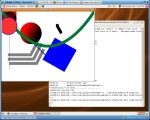What the flash?
What is Hxcpp? Hxcpp is the c++ backend for haxe. This means you can compile haxe code to c++ code, and then compile this to a native executable, for Windows, Linux or Mac.
What is NME? NME is the “Neko Media” library that wraps SDL, providing gaming interfaces for neko, and now native compiled haxe code.
What is Neash? Neash is a compatability layer that presents the flash API to haxe code running on other systems, such as js, neko or c++ native code.
Together these allows you to write code to target flash SWF files, and also cross compile to native code for Windows, Linux or Mac.
Hxcpp on haxelib
I have finally packaged up a bunch of changes into offical haxelib releases. Hxcpp is now on haxelib, which means you can get it with “haxelib install hxcpp”. This effectively creates a whole separate install of haxe, which can be run side-by-side so you can test it out without risk.
The cpp backend now supports Mac(intel) and Linux as well as the original Windows platform.
The main change to hxcpp is the packaging – moving towards a the final installation form. Currently there are a whole bunch of files distibuted in this release that should become redundant once the c++ backend is merged into the main branch. Also, the library coverage has been expanded a bit, but it is still not complete.
Usage
Firstly, you will need to run “haxecpp” instead of “haxe”. This executable is found in the appropriate bin subdirectory. I’m not sure if the “executable” flag will survive the compression, so you may need to “chmod a+x” the file.
It is probably best to place the appropriate bin directory in your executable path. On windows, this will also solve the problem finding the dynamic link library, hxcpp.dll. And on all systems, this will allow you to use the “make\_cpp” command from the hxml files. On Linux systems, you will have to allow the executable to find the hxcpp.dso. This is most easily done by setting LD\_LIBRARY\_PATH to the bin/Linux directory, or copying this file into an existing library path. Similarly on Mac, you should set DYLD\_LIBRARY\_PATH.
To build haxe code, use “haxecpp” inplace of “haxe”, with a target specified by “-cpp directory”.
This will place source code and a makefile in the given directory. Then you need to do a “make” on linux/Mac, or “nmake” on Windows to build the executable. You may need to set the environment variable “HXCPP” to point the the directory that contains this file. On windows, this will be something like: c:\Progra~1\Motion-Twin\haxe\lib\hxcpp\0,4\
As a shortcut, if you are using a hxml file, you can use “-cmd make_cpp” which will do the build for you assuming you used the “-cpp cpp” directory.
Neash/NME
The big changes for NME is that it now supports Linux and Mac(intel) for neko ac c++ targets. There have been a few bug fixes as well as a few new features:
- Bitmap class
- Expanded and optimised TileRenderer for render scaled and rotated sub-rects from a surface
- A few smarts for finding fonts, if no ttf is supplied
- Some blend modes have been added
- Added scale9Rect
- Added drawTriangles, with perspective correct textures
ToDo
There is still plenty to do, including, but not limited to:
Hxcpp:
- Proper coverage of all APIs.
- Resolve the order-of-operation problem: In c++ f(x++,x++) is ambiguous as to what order the increments are performed. Or perhaps agree to live with it.
NME:
- Add all blend modes
- Add all filters
- Discuss with experts the merits of static vs dynamic linking Mac and Linux.
Neash:
- Sound is a big ommision
- Loader code
- Unit testing of supported APIs.
Despite these issues, I think there is a useful core of functionality here.
Let me know what you think.





